Animal testing: less is more
The Three Rs – ‘replace, reduce, refine’ – are intended to minimise the suffering caused by animal testing. But can the slogan keep its promise?
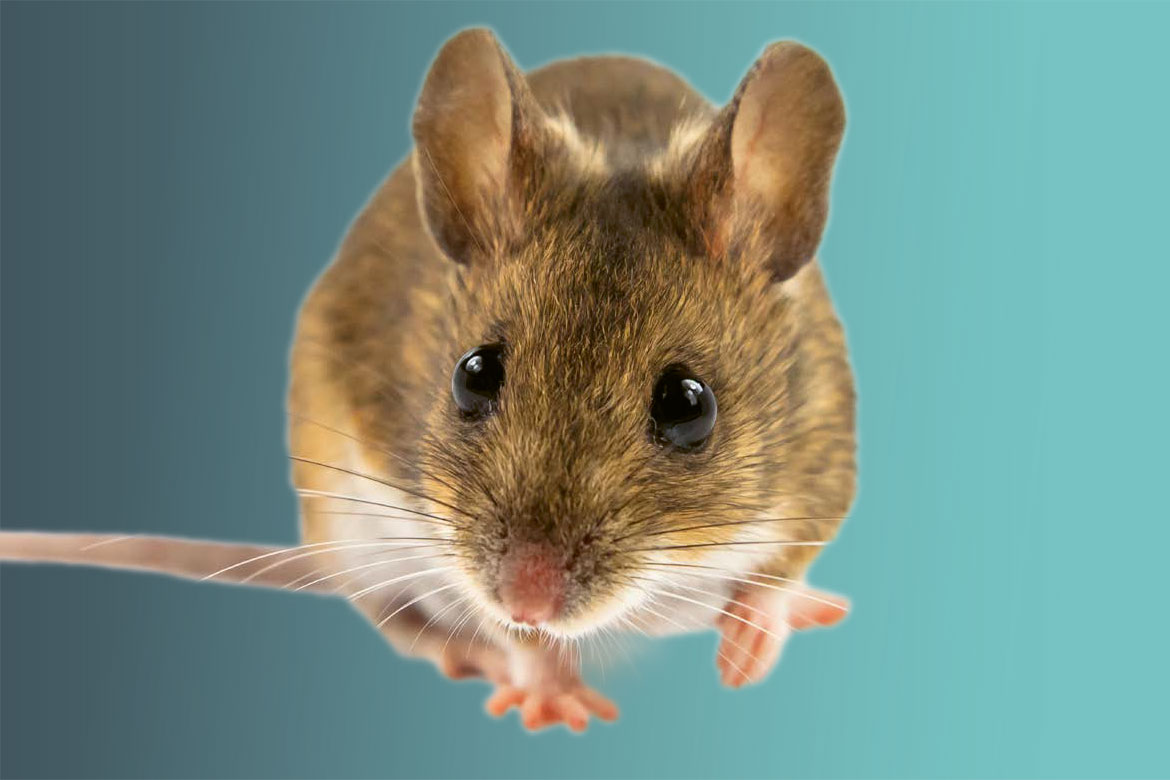
Image: Rudmer Zwerver/Shutterstock
When you think about the animals that suffer for science in the laboratory, you get a queasy feeling in your stomach. No one carries out animal tests for the fun of it. But the knowledge gained from them has time and again resulted in medical progress – also in the veterinary sciences. Legislators have also taken into account the ethical dilemma that arises when weighing up the possible benefits for humankind against the suffering of the animals themselves: according to the law, animal tests are “to be limited to that which is strictly indispensable”.
That was also the reasoning behind the three Principles of Humane Experimental Technique that were drawn up back in 1959 by a zoologist and a microbiologist from the United Kingdom. Their intention was to make animal tests more humane. Wherever possible, researchers should pursue alternative options (‘replace’), use as few animals as necessary (‘reduce’) and take as much care as possible when designing the tests (‘refine’).
The Three Rs are neither a complete rejection of animal testing, nor do they offer researchers a free pass. Instead, they require animals to be treated with care. This is also to the benefit of science, because the results gained become more meaningful, more universally valid, and more reproducible.
What the alternatives can achieve
Finding suitable replacements for every animal test is going to remain a pipe-dream. But the alternatives are interesting not least because they also offer new research methods. All the same, not all replacement methods are equally valid. We offer an overview here.
CELL CULTURES
HUMAN TESTING
ORGANS ON CHIPS
SIMULATION
CELL CULTURES
Big potential in the petri dish
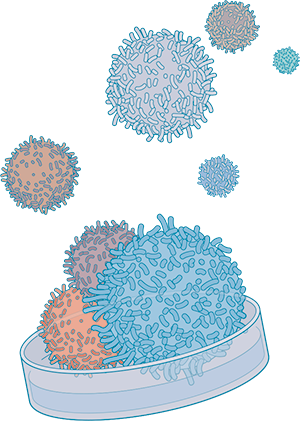
Illustration: Tara von Grebel
Enormous progress has been made with cell cultures. Even today, they are replacing animal tests successfully. These cultures also allow us to experiment directly with human material. For example, realistic human skin tissue can be replicated allowing the cosmetics industry to continue testing product tolerance levels. “Working with the cells of both healthy and sick people can provide us with insights that would never be possible with animal tests”, says Stefanie Schindler, Co-CEO of the Animalfree Research Foundation, which supports research aimed at making animal tests unnecessary.
If no human donors are available, then there is the possibility today of creating stem cells from normal adult body cells (induced pluripotent stem cells, also known as iPS cells). In principle, these can be turned into any body part – such as heart muscles that will actually beat.
Most cell cultures used today consist of a layer of individual cells that are spread over a specific surface. But this does not correspond to their natural environment, so it results in an unrealistic model for their actual situation in the body. For this reason, large sums of money are being invested in three-dimensional tissue reconstruction.
Cells are attracted into the right places using scaffolds and hydrogels – or they are placed correctly using a 3D printer. Another possibility is to have them organise themselves, letting them stick together in a drop of water or at the bottom of tiny cavities to form spherical mini-organs (so-called organoids). If you use the right mixture of different cell types, then you can produce models of brain tissue, connective tissue and tumours.
HUMAN TESTING
Direct tests on patients are forbidden
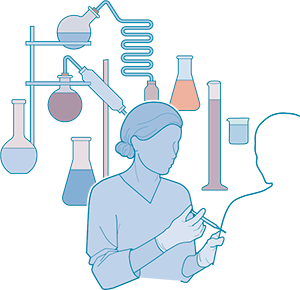
Illustration: Tara von Grebel
Animal tests are unreliable. Less than one in ten active substances cleared by animal tests actually ends up being allowed on the market. Those that do undergo clinical tests on humans might still prove to be either harmful or simply ineffective. Nevertheless, the process of animal testing does winnow out many dangerous or ineffective substances.
If we were to renounce all animal testing, we would either have to cease developing any new products, or start testing them directly on human subjects. But, as Ernst Hunziker says: “You can’t go directly to human tests”. That’s why laws and regulations today prescribe a kind of cascade mechanism: first you conduct tests on cells, then on tissue and organ cultures, then on animals and only then on humans.
ORGANS ON CHIPS
The long path to artificial organs
A single cell culture cannot act as a model for the complex interaction between different cell types in an organ. For example, chemical substances might be transformed in one place, and are only then able to exercise their destructive or healing properties in another place. But this situation can be reproduced on a chip. By cutting small channels on its surface, cell cultures can be linked together and exchange substances.
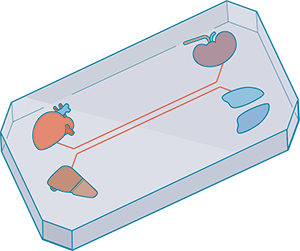
Illustration: Tara von Grebel
The greatest potential of this ‘organ on a chip’ lies in testing new chemical substances. “In the field of toxicology, we could soon be able to renounce all animal tests”, says Stefanie Schindler. The Dutch government is actually planning to halt all animal tests in toxicology by the year 2025.
In order to reproduce absolutely all aspects of organs, many further factors have to be borne in mind. In a lung, for example, the vesicles are subjected to mechanical stress by breathing in and out. This can be mimicked mechanically, but Schindler admits that “the method is still a long way from achieving a complete, artificial organism”.
SIMULATION
Important, but never complete
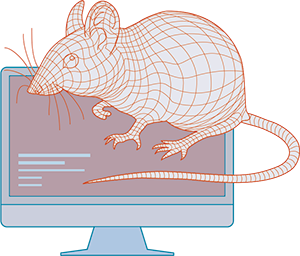
Illustration: Tara von Grebel
“Without computer modelling, complex phenomena simply cannot be accounted for”, says Uwe Sauer of ETH Zurich, who has already simulated the sugar metabolism of a simple model bacterium. With carefully calculated hypotheses, research becomes more target-oriented. And that can replace a lot of unnecessary animal tests.
But simulations cannot replace animal tests entirely. They have to be based on information acquired in the real world. Ernst Hunziker, the President of the 3R Research Foundation, puts it like this: “You can never predict everything that will happen in vivo”. One tragic example was the sleeping pill Thalidomide, which caused children to be born with physical malformations. “That couldn’t even have been predicted using animal tests”.
Quality instead of quantity
Paradoxically, expanding tests could reduce the number of animals tested.
In Switzerland, the number of animals used in tests was reduced from almost two million in 1983 to less than 750,000 in 1996. Since then, the figures have remained stable. Fewer and fewer animals are needed for testing pharmaceuticals. But this is offset by a rising number being used in basic research. “This intensification is largely a result of the increased use of genetically altered mice”, says Stefanie Schindler from the Animalfree Research Foundation.
The foundation donates to research projects whose goal is to make animal testing completely unnecessary. Schindler is aware that this is a long-term prospect, but she is convinced that it can be achieved. The spread of the Three Rs is an intermediary step that the Foundation hopes will help it reach its end goal. To this end, they have supported the project behind an online tool aimed at helping researchers to find scientific literature on the Three Rs, and to integrate alternative methods into their project planning.
By improving the quality of tests, the number of animals needed for them can be reduced. In other words: researchers should refrain from repeating tests unnecessarily and should aim for the highest possible informative value for each test. However, this could also lead to larger tests being carried out using a greater number of animals per test.
For this reason, the specialist journal Nature launched a new type of article in 2017, for meaningful ‘preclinical studies’. Nature wants promising therapies to fail less often when they reach the clinical testing phase on humans. Hanno Würbel, a professor of animal welfare at the University of Bern, believes that they are heading in the right direction: “If in the end too few animals are used to achieve valid results, then this is wasteful too”. In other words, animal tests are increasingly being inspired by the same attitudes behind human testing.
“Fear and stress are the biggest confounding variables”
If suffering is minimised and animal welfare improved, it also increases the scientific validity of an experiment, says Hanno Würbel, who represents the University of Bern at the new 3Rs Competence Centre of swissuniversities.

Image: Marco Zanoni/Lunax
How can we find out if test animals are suffering, and by how much?
That’s the great question in our field, because we are trying to measure subjective sensations, such as pain and fear, that you can’t measure objectively. Nevertheless, indicators such as life expectancy, rate of disease, stress hormone levels and behavioural changes can be objective, decision-making aids.
How can the suffering of laboratory mice be reduced in concrete terms?
The most important thing when keeping mice is to have sufficient nesting material. But you need qualified animal keepers who can recognise and assess problems and who are allowed to try out new solutions.
Some researchers complain that commissions on animal testing are not competent enough to assess suffering.
I’ve already heard that one – mostly anonymously. It’s true that the commissions are overstretched because they have too many tasks to fulfil. That’s why I’m arguing in favour of research institutions themselves taking more responsibility, both for the Three Rs and for the scientific quality of their tests. Commissions should have the exclusive task of assessing the plausibility of the researchers’ own balanced assessments.
Do major abuses occur in research?
Often, an animal is misunderstood as being a kind of measuring instrument. Researchers try to ‘standardise’ them, and for that reason they reject any proposals to keep them in a more sophisticated environment. They claim that this would cause a loss of precision. But that is a misconception from a biological perspective, because the more precise the results, the less universal their validity. Furthermore, stress and fear are the biggest confounding variables, and can also influence the immune system. Keeping animals in better conditions leads to results with greater validity.




